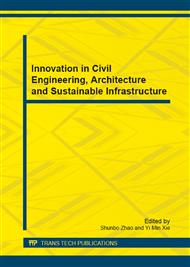p.435
p.441
p.447
p.451
p.455
p.460
p.466
p.470
p.473
Influence of Compaction Density of Soil Mass to the Seepage Build Capacity of Rain and Drainage Design Parameter
Abstract:
To reduce the pressure of rain efflux in the airport, and make full use of the resources of rain, the adjustment relationship between seepage build capacity of the soil surface area and rain convergence is studied. The condition of constraints between surface rain gradient and emissions is analyzed, according to airfield drainage design. The method to determine the ratio of the seepage area and non-seepage area is proposed to take full advantage of the rainwater seepage build capacity of soil surface area. Experiments have been performed to study the influence of infiltration rate of compaction density to clay and silty soil. The experimental results show that the soil infiltration rate decreases linearly with the increase of soil compaction, and reduces very fast at the first 30min of rainfall. It is recommended that the infiltration rate of rainfall on the first 30min can be used as the design parameter in the drainage design in the airfield. The influence coefficient reflecting the influence of compaction density to soil infiltration rate has been proposed.
Info:
Periodical:
Pages:
455-459
Citation:
Online since:
November 2012
Authors:
Price:
Сopyright:
© 2012 Trans Tech Publications Ltd. All Rights Reserved
Share:
Citation:


